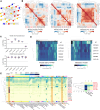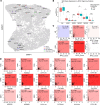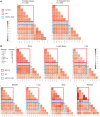Androgen production, uptake, and conversion (APUC) genes define prostate cancer patients with distinct clinical outcomes
- PMID: 39207857
- PMCID: PMC11530133
- DOI: 10.1172/jci.insight.183158
Androgen production, uptake, and conversion (APUC) genes define prostate cancer patients with distinct clinical outcomes
Abstract
BACKGROUNDProstate cancer (PC) is driven by aberrant signaling of the androgen receptor (AR) or its ligands, and androgen deprivation therapies (ADTs) are a cornerstone of treatment. ADT responsiveness may be associated with germline changes in genes that regulate androgen production, uptake, and conversion (APUC).METHODSWe analyzed whole-exome sequencing (WES) and whole-transcriptome sequencing (WTS) data from prostate tissues (SU2C/PCF, TCGA, GETx). We also interrogated the Caris Precision Oncology Alliance (POA) DNA (592-gene/whole exome) and RNA (whole transcriptome) next-generation sequencing databases. Algorithm for Linking Activity Networks (ALAN) was used to quantify all pairwise gene-to-gene associations. Real-world overall survival was determined from insurance claims data using Kaplan-Meier estimates.RESULTSSix APUC genes (HSD3B1, HSD3B2, CYP3A43, CYP11A1, CYP11B1, CYP17A1) exhibited coalescent gene behavior in a cohort of metastatic tumors (n = 208). In the Caris POA dataset, the 6 APUC genes (APUC-6) exhibited robust clustering in primary prostate (n = 4,490) and metastatic (n = 2,593) biopsies. Surprisingly, tumors with elevated APUC-6 expression had statically lower expression of AR, AR-V7, and AR signaling scores, suggesting ligand-driven disease biology. APUC-6 genes instead associated with the expression of alternative steroid hormone receptors, ESR1/2 and PGR. We used RNA expression of AR or APUC-6 genes to define 2 subgroups of tumors with differential association with hallmark pathways and cell surface targets.CONCLUSIONSThe APUC-6-high/AR-low tumors represented a subgroup of patients with good clinical outcomes, in contrast with the AR-high or neuroendocrine PCs. Altogether, measuring the aggregate expression of APUC-6 genes in current genomic tests identifies PCs that are ligand (rather than AR) driven and require distinct therapeutic strategies.FUNDINGNCI/NIH 1R37CA288972-01, NCI Cancer Center Support P30 CA077598, DOD W81XWH-22-2-0025, R01 CA249279.
Keywords: Bioinformatics; Molecular genetics; Oncology; Prostate cancer.
Figures







Similar articles
-
Regulatory genes in the androgen production, uptake and conversion (APUC) pathway in advanced prostate cancer.Endocr Oncol. 2022 Jun 7;2(1):R51-R64. doi: 10.1530/EO-22-0058. eCollection 2022 Jan. Endocr Oncol. 2022. PMID: 37435458 Free PMC article. Review.
-
Androgen action in the prostate gland.Minerva Urol Nefrol. 2012 Mar;64(1):35-49. Minerva Urol Nefrol. 2012. PMID: 22402316 Review.
-
Targeting the androgen receptor signaling pathway in advanced prostate cancer.Am J Health Syst Pharm. 2022 Jul 22;79(15):1224-1235. doi: 10.1093/ajhp/zxac105. Am J Health Syst Pharm. 2022. PMID: 35390118 Review.
-
A novel DNA methylation signature is associated with androgen receptor activity and patient prognosis in bone metastatic prostate cancer.Clin Epigenetics. 2021 Jun 30;13(1):133. doi: 10.1186/s13148-021-01119-0. Clin Epigenetics. 2021. PMID: 34193246 Free PMC article.
-
Androgen Receptor Splice Variant 7 Predicts Shorter Response in Patients with Metastatic Hormone-sensitive Prostate Cancer Receiving Androgen Deprivation Therapy.Eur Urol. 2021 Jun;79(6):879-886. doi: 10.1016/j.eururo.2021.01.037. Epub 2021 Feb 10. Eur Urol. 2021. PMID: 33579577
Cited by
-
Investigation of GPR137C as a promising novel marker for the progression of prostate cancer through G4 screen and bioinformatics analyses.Front Immunol. 2025 May 30;16:1576835. doi: 10.3389/fimmu.2025.1576835. eCollection 2025. Front Immunol. 2025. PMID: 40519905 Free PMC article.
-
Current uses and resistance mechanisms of enzalutamide in prostate cancer treatment.Expert Rev Anticancer Ther. 2024 Nov;24(11):1085-1100. doi: 10.1080/14737140.2024.2405103. Epub 2024 Sep 20. Expert Rev Anticancer Ther. 2024. PMID: 39275993 Review.
References
MeSH terms
Substances
Grants and funding
LinkOut - more resources
Full Text Sources
Medical
Research Materials
Miscellaneous

